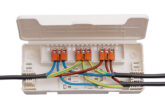
Mechanical Ventilation with Heat Recovery (MVHR) is a huge opportunity for electricians to grow their business, but can be daunting for those unfamiliar with it. National Ventilation’s Christian Rehn explains the importance of proper system design and offers tips on ductwork installation.
MVHR is increasingly the ventilation system of choice for new build homes and offers a solution to meeting airflow and DER requirements.
But when installing a whole house ventilation system, electricians need to be familiar with the design and specification of this technology and the ducting that goes with it.
What can electricians who aren’t sure how to specify this technology do?
Thankfully, there are design services available to help electricians secure these projects. For example, National Ventilation specialises in offering a free design service that supplies a full design and quotation including unit calculations, a full kit list, recommended duct routes as well as ensuring it meets Building Regulations.
And whilst it’s essential to select the right MVHR unit for the job, it’s also important to choose the right ductwork and to install it correctly.
Here are seven steps that will help you achieve a good ductwork installation.
- Design early on
It is vital whole house ventilation is designed early in a project to ensure the system provides the correct levels of ventilation and works within the structure. Using architects’ drawings and property details, data is inputted into an airflow calculator to ensure the ventilation specified meets airflow demands. The correct size ventilation unit and the correct type of ducting can then be specified.
- Choose the best location
MVHR units are often located in lofts, but can also be located in a utility room. Ducting often goes in the ceiling void but if there is a vaulted ceiling an alternative is running ducting through webbed eco joists, between floors or within stud walls.
- Specify easy to install ducting
Larger projects generally use traditional rigid ductwork, which requires experience and time to install correctly. For smaller developments, semi-rigid ducting is a simple alternative that is easy and quick to install.
It is low profile and flexible so perfect for installing in places where space is restricted. It’s available in lengths of up to 50m meaning far fewer connections and easier routing. For example, National Ventilation’s Monsoon Radial ducting is flexible enough to fit into tight corners but still rigid and robust enough not to be crushed. It’s also up to 60% quicker to install.
- Minimise connections
Each ducting connection needs to be sealed and with each seal there is a greater risk of a leak. Rigid ductwork runs down a central spine with ducting feeding from it, with additional lengths of ducting every metre, which adds up to a lot of connections.
In contrast, with Monsoon Radial semi rigid ductwork there is a central manifold with a single length of pre-sealed ducting running to the unit and the air valve, meaning there are only two joints required, minimising air leakage so that the fan performs as intended.
To connect to a component the ducting is just pushed into the connector, turned clockwise, once it clicks twice it is sealed, with no need for tape or mastic. This makes the installation very simple so even a novice can install it to a high standard.
- Avoid bends
Bends affect airflow. Using semi-rigid ductwork means fewer bends so resistance is minimised, improving air flow and making the system more energy efficient and quieter.
- Use an induct humidistat
Traditionally MVHR is often boosted on bathroom lighting meaning systems can boost unnecessarily. Alternatively, an in-duct humidistat means the boost only triggers when humidity rises, it takes less time to install and is more cost effective since less wiring is needed. Installers only need to wire the humidistat back to the fan as the fan is constantly on.
- Commission the system
Once installed, electricians should run a final check of the ducting and then commission the MVHR unit to check the airflow is correct. Some of the latest MVHR units, such as the IntelliSystem from National Ventilation, feature App controlled commissioning, encouraging best practice and high performance through simplified commissioning.
Installers can check that the ductwork is fitted correctly via the App and can also check airflow is correct.
TO GET MORE DETAILS ABOUT NATIONAL VENTILATION’S DESIGN SERVICE CLICK HERE











